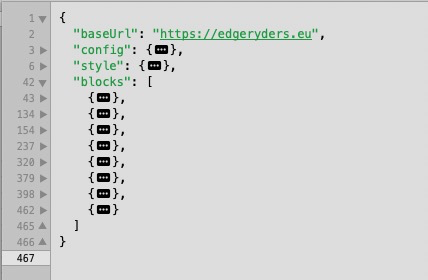I have been “user zero” for the webkit. After two weeks of intense interaction with @owen, Marina and I (but mostly me when it comes to handling the configuration files) are quite happy with our first result, https://research.edgeryders.eu. Still some very minor thing missing, but the site is now in use. In general, I think you guys in the tech team (@matthias, @hugi, Owen himself) were right, and this is the way to go.
During this test, an important pivot happened. Owen decided that JSON is not a good choice as the format of the configuration file, and switched to XML instead. Also, we discovered four things, that I consider important for the future development of the webkit.
-
The documentation now serves much more third-party users of the webkit than people in Edgeryders. Both the repo and the documentation website resemble those of a normal open source project. They are completely useless to Marina, or Andreja. This is not a complaint, but a recommendation that that part of the documentation is now dropped, and some effort is put into making a step-by-step manual to making a website with the webkit. I am willing to contribute to it. From Owen’s side, the first thing that needs to happen is that he produces an equivalent of the JSON example configuration file in XML. In general, the switch to XML has rendered obsolete part of the documentation.
-
The Discourse editor sucks at writing code. You get very frustrated when trying to edit code from within Discourse. When we were doing JSON, my workflow was like this:
-
Copy-paste the JSON config file into TextMate.
-
Use the collapse function of TextMate to render the JSON at the highest level, like this:

-
Expand one block at a time, make the edit, re-collapse, etc.
-
Copy-paste the result back into Discourse.
Now I will need to find something similar for XML.
-
-
To avoid messing with the configuration files, there should be almost no text in them. Everything should be written in normal posts on Discourse, and the configuration file should point to those posts:
<Text topic="12345/1"></Text>
By the same token, everything accessible via edgeryders.eu API should be made available to the webkit. For example: whole categories; topics by tags; users, etc.
- There is a need for themes, to standardize the Edgeryders look and feel and reduce the need for tweaking things. My next website is going to be the SF-ECON website. I am completely OK with it looking exactly like the RezNet website (of course, with its own logo, colors, and images, but same theme). If we don’t do that, we are going to spend a lot of time asking Owen to tweak things and the websites will bear no similarity to each other. Aligning the content is very fast with the webkit, so that 80% of the work is done in three hours, but without good theming the remaining 20% will take two weeks, and then, like Nadia says, we might as well build one-off Wordpress websites.
Can I ask @hugi to incorporate these suggestions in future development decisions, and in how Owen’s time is allocated?